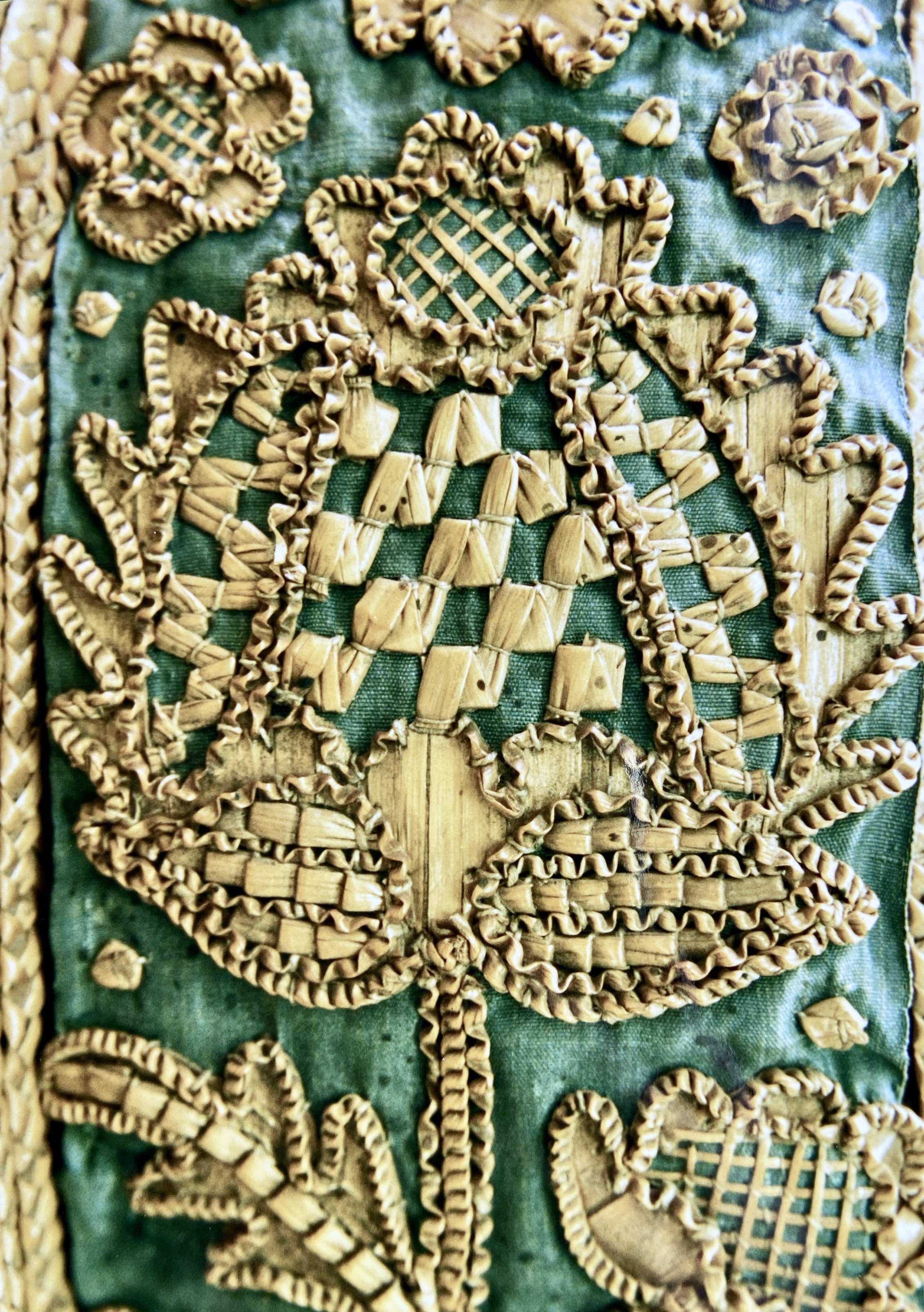Embroidery with Straw
“Straw ! Straw ! Straw ! every thing is ornamented with straw from the cap to the shoe buckle : and Ceres seems to be the favorite idol with not only the female, but the male part of the fashionable world, for the gentlemens waistcoats are ribbed with straw and they look as if they had amused themselves in Bedlam for some time past, manufacturing the flimsy doublet.”
The use of straw, or straw products to embellish fabrics can be dated back to the 1600s, and possibly earlier. The subject requires far more research. Often regarded as a gentile occupation by ladies or those in religious orders, there are indications that by the 1700s it was a commercial enterprise by 1783 when The European Magazine and London Review reported it as a fashion trend throughout that spring in London.
Embroidery with straw disappears and reappears throughout the 1800s, dictated by fashion, and appears to enjoy its final flourish in the early 1900s. Today major fashion designers such as Dior are attracted to include straw in their couture collections.
This section cannot hope to include all the surviving examples held in museums, churches and private collections around the world instead it invites you to continue your research.
Embroidery in the 1600s. Ecclesiastical work
The church collection at Nozeroy, Jura Region, France comprises several pieces including alter frontals. All are thought to have been made by nuns in the mid 1600s, however examination of the techniques and patterns indicate they may have been created over a longer period. The straw has been prepared into strips, sometimes called straw ribbons, and straw sheets that have been embossed. Outlines are made using a fine two-straw plait. Rather than taking the straw through the silk fabric the straw products have been couched onto the surface.
Whilst much of the early work is associated with France it is interesting to note that the Victoria and Albert Collections include one piece that is attributed to Spain, 1650-1680 having been purchased in Toledo. The border is a later addition. While lacking the variety of straw work incorporated into the Nozeroy pieces, this is very similar to the image robe pieces including the one shown below.
The two-end plait is applied to red silk backed with linen and the entire cover is believed to comprise three pieces.
The fragment shown (393 to B-1896) is one of several thought originally to have been image robes. The silk fabric was originally red and the two-straw plait has been couched onto the surface. While there is no confirmed provenance for these pieces, they are believed to have been made in France. While the pieces shown are thought to have originated in France, there are other examples thought to come from Czechia, Belgium and Italy. Much more research is required to establish how widespread this form of embroidery was at this time.
Embroidery in the 1700s. Entry into costume fashion
By the 1700s straw embellishment is found outside the church and is in use for fashion. pocket books, letter cases, brise fans, shoes and stomachers provide evidence of the appeal of straw in this century. Examples exist in museum collections around Europe and can even be found in North America.
The pocket book shown is in the collection of the Victoria and Albert Museum, London. Thought to date to 1720 – 1740 as with so many surviving pieces it pre-dates the account in The European and London Review possibly by sixty years. The V&A collection includes several pieces and is worth investigating. Much of the straw work is combined with metal and silk threads, but the technique still involves couching narrow split straws, wider straw ribbons, or shaped straw sheets onto the fabric. As can be seen on the pocket book, the straw is being coloured, as well as being natural.
Straw is also being worked using the Or Nué technique, instead of gold tape, straw is used and couched with coloured silk threads to create the designs. This stomacher is dated to the 1760s and attributed to work from either France or Italy.
While France is established as a centre of production, and the cover attributed to Spain, there is insufficient research to understand the spread of this work through Europe. Embroidery with straw has now spread from simply religious work, undertaken by nuns, to fashion items. Perhaps this indicates a move to work on a more commercial scale.
In the mid 1700s shoes are also being made using straw embroidered panels. As described in the European Magazine and London Review, in the 1700s straw does adorn the body from head to toe.
Does a gentleman’s waistcoat decorated with straw lay hidden in a collection somewhere?
Embroidery in the 1800 and 1900s – working onto tulle and into the fabric
More information coming soon …






